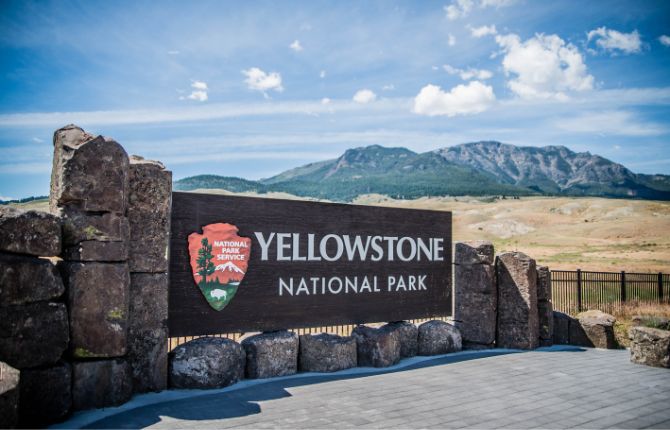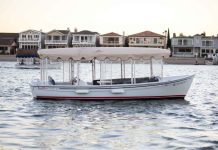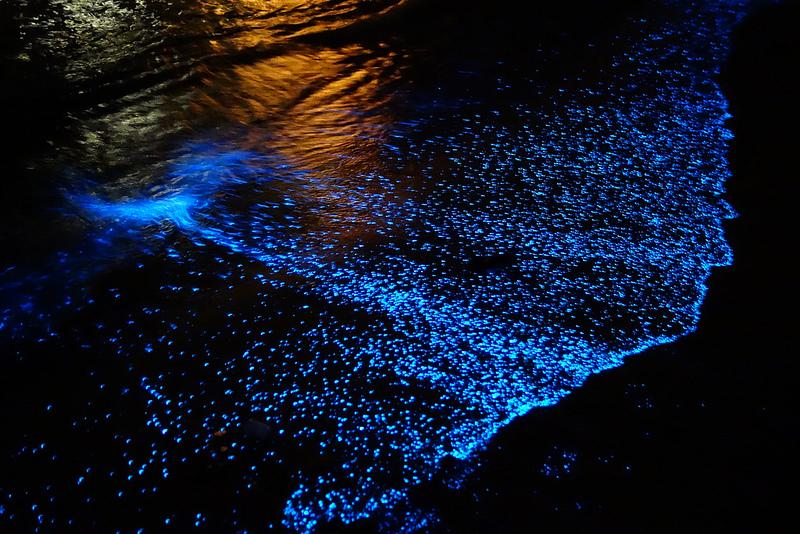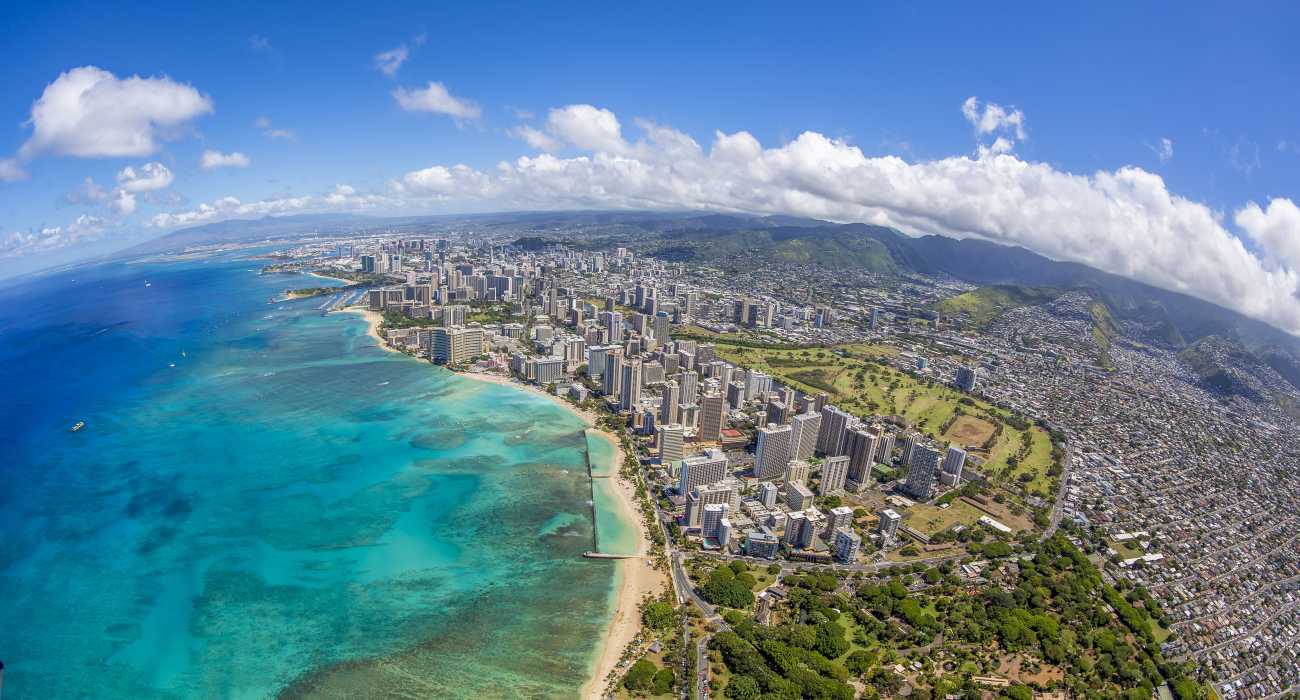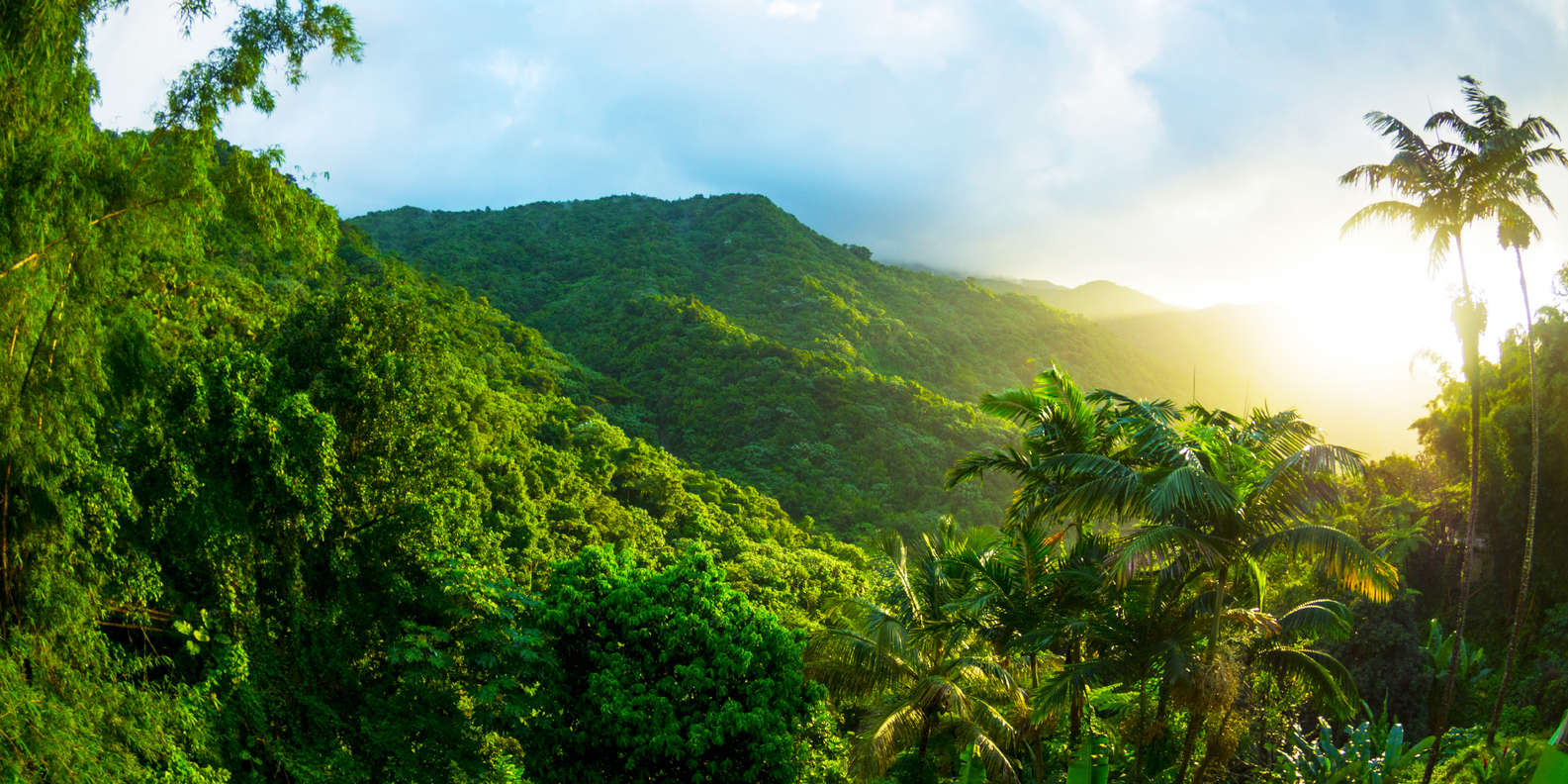Are you planning a trip to Yellowstone National Park in the USA?? This article will help you to discover more places and things to do at the park.
Yellowstone National Park was opened in 1872 and is considered the oldest national park in the United States. Also, it is one of the most popular parks. Located atop a volcanic hotspot, it mostly spreads in Wyoming. And it extends through Montana and Idaho too.
Have you heard about the Greater Yellowstone Ecosystem? It is one of the largest and best temperate-zone ecosystems in the world.
And, of course, Yellowstone National Park is home to alpine rivers, dramatic canyons, thundering waterfalls, scenic valleys, lush forests, and the world’s largest number of active geysers.
Check the following list of things to do in Yellowstone National Park in the USA.
Where is Yellowstone National Park
If you’ve ever wondered, “Where is Yellowstone National Park?” you’re not alone. It’s a huge park mostly in Wyoming, spanning over 2.2 million acres and over three thousand square miles – more than 24 times the size of Rhode Island.
However, Yellowstone is large enough to be challenging to visit on foot and is more accessible than you might think. Depending on your vehicle’s size, you can take a road trip or rent a car.
First-time visitors to Yellowstone often ask, “Where is Yellowstone National Park?” The answer is different for every traveler, but the general location is in Wyoming, though parts of the park are also in Montana and Idaho.
Yellowstone is about a thousand miles from the West Coast and one and a half hours away from the Great Lakes.
While you’re there, you’ll want to know when to visit the park. It’s best to go any time of the year, though you can get into the park in April when roads are open for hiking.
In spring, you can expect to see various wildlife as wildflowers break through the snow. Alternatively, you can choose to visit during a quieter season, such as the winter, when fewer tourists are present.
Things to Do in Yellowstone National Park
1. Old Faithful
If you’re interested in volcanoes, you’ve probably heard of Old Faithful in Yellowstone National Park. This geyser’s height varies between 100 and 180 feet, but on average, it sits around 130-140 feet.
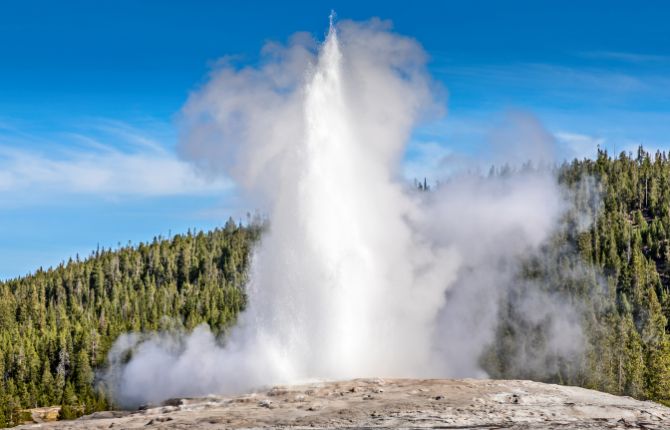
While the duration of its eruptions is predictable (every 44 minutes to two hours since 2000), you can surely count on seeing one during your visit. In addition, you can see it from a distance via the boardwalk that runs through the Upper Geyser Basin.
In 1870, the Washburn Expedition discovered the region’s geysers and named it Old Faithful.
In the late spring, early summer, and fall, you can see Old Faithful. You can also see the geyser at other times of the year, as the roads to the geyser close in late fall.
These roads reopen in mid-December but are close to over snow traffic. A snow coach or snowmobile can get you to the geyser, which can be an excellent alternative to driving.
There are over a thousand geysers in Yellowstone National Park. Each geyser is unique, but all have one common characteristic: they erupt at least once every 90 minutes.
Geysers like Old Faithful are part of a volcanic system where hot magma chambers are below the surface. The molten rock causes the water below to become superheated, building pressure underneath it.
Once it boils, the water becomes steam, which erupts as geysers. Old Faithful is a cone geyser covered in siliceous sinter and spews boiling water as high as 184 feet. The average time between eruptions is about 92 minutes.
There are several accommodations at the park, including the Old Faithful Inn. Built-in 1903-1904, it’s the largest log structure in the world. Robert Reamer built the Old Faithful Inn, using rhyolite for the foundation and Lodgepole pines for the walls. The buildings blended in with the surrounding temperate forest.
The Old Faithful Visitor Center has information on the geothermal and Yellowstone volcano. The Visitor Education Center provides exhibits, movies, and park research activities.
The Young Scientist Exhibit Room is an interactive environment with hands-on exhibits and information stations. A library houses books and other resources on all aspects of Yellowstone.
Address: Yellowstone National Park, WY 82190, United States Phone: +1 307-344-7381
2. Upper Geyser Basin in Yellowstone National Park
Hiking in Upper Geyser Basin is one of the best ways to experience the park’s amazing hot springs and colorful pools. It has the highest concentration of geysers in the world.
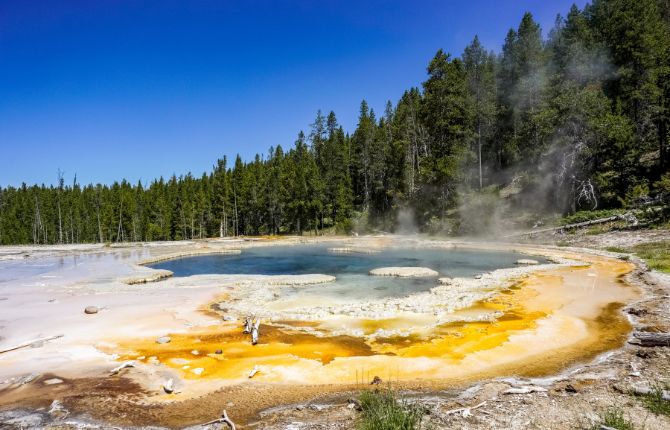
It also offers a variety of geological features, including the stiffness of the hills, which were formed from silica-rich lava. While hiking in this area, make sure to plan your trip so that you can see as many of the geysers as possible.
The Upper Geyser Basin eventually became a popular destination and a famous place to stay. A two-hour boardwalk trail takes you to several amazing places, including Giantess Geyser, Old Faithful, Beehive Geyser, Grand Geyser, Castle Geyser, and fountain basins.
Many geysers surround the Upper Geyser Basin. The Anemone Geyser, for example, erupts every ten minutes and reaches a height of 10 feet. Another notable feature is the Doublet Pool, which has two adjacent springs.
The Beauty Pool features a broad band of cyanobacteria almost to the boardwalk trail. In addition to the Beauty Pool, the Upper Geyser Basin also features the Liberty Cap, a twelve-meter-high mineral deposit formed over a long period.
The Upper Geyser Basin contains more than 10,000 hydrothermal features. You can find Morning Glory Pool on the north edge of the Upper Geyser Basin. And also, Biscuit Basin is a part of the Upper Geyser.
Of course, the Old Faithful Geyser is the most famous feature in the park, shooting a hundred to 185 feet into the air and lasting anywhere from one to five minutes. It is a sight to behold.
With the park’s beautiful pools, Upper Geyser Basin is a great place to explore the hot springs in the area.
3. Morning Glory Pool
A popular tourist attraction in Yellowstone National Park, the Morning Glory Pool has a fantastic array of colors caused by bacteria in the water.
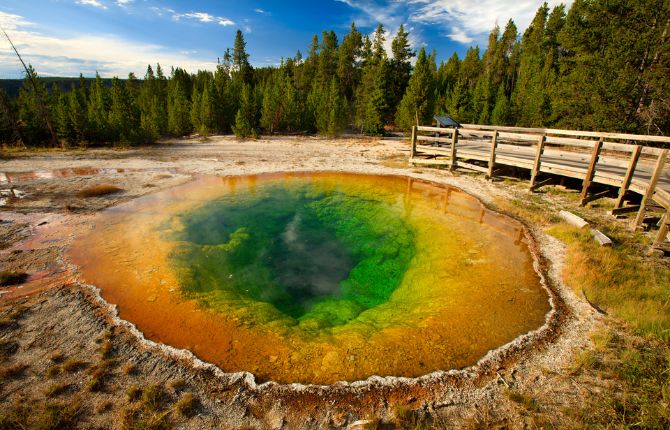
Once a soft, delicate blue, this pool now features yellow, orange, red, and green hues. The color change is due to the bacteria and the fact that tourists have been known to throw trash into the pool.
This trash and coins have caused the water to change temperature and circulation, altering its colors.
The Morning Glory Pool’s blue color results from thermophilic bacteria seeking heat and oxygen. Unfortunately, a lot of trash has accumulated in the Morning Glory Pool over the years, blocking the vent and preventing proper circulation.
Other microorganisms also infiltrate the water, causing it to appear blue. Earlier visitors chipped away at the scalloped sinter fringe to collect souvenirs.
The Morning Glory Pool is an area of thermal features that once dominated the Upper Geyser Basin. It’s 1.6 miles north of Old Faithful.
During your hike, you’ll pass a dozen or so dispersed springs. The trail continues past Biscuit Basin, where you can enjoy the Morning Glory Pool’s stunning view from a raised boardwalk.
In the 1950s, rangers began informally referring to the Morning Glory Pool as a “garbage can” to discourage souvenir hunting.
Address: Yellowstone National Park, WY 82190, United States Phone: +1 307-344-7381
4. Midway Geyser Basin in Yellowstone National Park
While you may be drawn to the Grand Prismatic Spring as the highlight of your Yellowstone National Park visit, it is worth spending more time exploring the rest of Midway Geyser Basin.
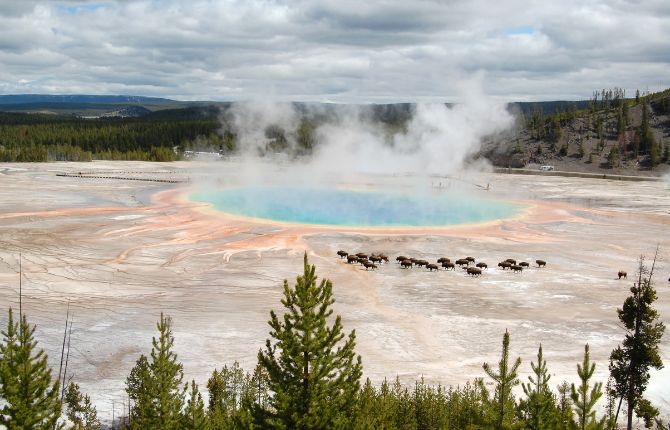
It is located between the Upper and Lower Geyser Basins. Excelsior Geyser typically releases 55 gallons of hot water per second into the Firehole River.
Though they don’t garner as much attention as the Grand Prismatic Spring, the other hydrothermal features here have a fascinating history.
Midway Geyser Basin is situated in southwest Yellowstone National Park, just 11 miles south of Madison Junction. You can access the park’s Midway Geyser Basin by traveling the Grand Loop Road or taking a short hike along the Fairy Falls trail.
From here, you can enjoy a breathtaking aerial view of the Grand Prismatic. After exploring the Midway Geyser Basin, head back to Old Faithful for a spectacular sunset or evening.
If you’d like to enjoy this geyser basin, make sure to arrive early. The parking lot fills up quickly in the summer months, so you’ll want to plan your visit accordingly. For a more relaxed experience, come early or late in the evening.
Once you’ve parked, walk toward the Firehole River and the Basin’s most prominent hydrothermal features.
Midway Geyser Basin is one of the tiniest geyser basins in Yellowstone, but its four hydrothermal features make it a top attraction.
The area’s grand Prismatic spring, Grand Prismatic, is also part of the park’s corridor. While there, it’s well worth the short stop to see Midway Geyser Basin.
5. Grand Prismatic Spring
The color of the Grand Prismatic Spring comes from the unique combination of temperature rings in the water. It is a stunning and colorful spring that spreads over a 370-foot-wide area.
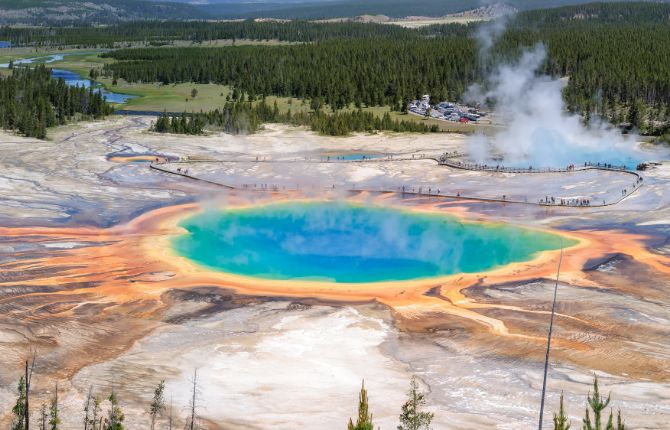
Each ring contains distinct species of bacteria, whose pigmentation varies depending on the temperature. Because the temperature changes constantly, the spring’s colors change throughout the year.
This unique feature of Yellowstone National Park is definitely worth a visit. You can do and see many things while you’re at it, but here are some tips for getting the most out of your trip.
If you’re visiting Yellowstone in the spring season, it’s best to plan your visit around when the colors are most vivid. Visiting in the spring’s peak season can be challenging, and the crowds can make parking a pain. You’ll also want to plan enough time to take the photographs you need to take.
The Grand Prismatic sits on a bed of rhyolitic rock, a light volcanic rock that is extremely high in silica content. The heat generated by magma causes water to rise and cool.
This water then is replaced by new, hotter water. The water does not form geysers, but the circulating water does produce silica sinter.
Address: Midway Geyser Basin, Yellowstone National Park, Teton County, Wyoming, United States
6. Lower Geyser Basin in Yellowstone National Park
The Lower Geyser Basin is a fascinating area in Yellowstone National Park. Originally established in 1872, this park was the first national park in the United States.
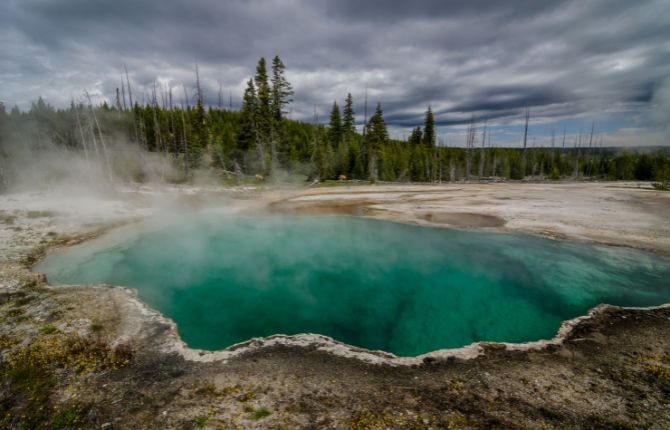
One of its most famous features is the Paint Pot, a boiling pool of mud composed of fine particles of silica and hot clay minerals. Its blooping and spitting sounds made it famous in photographs taken by William Henry Jackson in 1873.
The Lower Geyser Basin contains some of the most spectacular geysers in the world, including the Grand Fountain Geyser.
This area has a complex geothermal past, with hydrothermal activity and rhyolite lava flows shaping the landscape and sculpting the area into a flat landscape. Several trails lead to remote geyser groups, and you can even camp under the steaming mud.
The Lower Geyser Basin is located between the Madison Junction and Old Faithful. It is home to several hundred geysers and mud pots.
A visit to the basin is a must for any Yellowstone National Park visitor. While there, be sure to enjoy the world-class fly fishing! You’ll be able to catch a variety of fish in this area, including trout, rainbow trout, and salmon.
Another popular attraction at the Lower Geyser Basin in Yellowstar National Park is the White Dome Geyser. Visitors to the area are often delighted by its unusual style of eruption.
Some of these eruptions are so spectacular that some people even arrive earlier than the predicted times. The eruption begins slowly, with small bursts of water and a quiet interval between bursts.
However, suddenly, a huge burst of water shoots high into the air, and the crowd reacts with awe.
7. Norris Geyser Basin
The Norris Geyser Basin is the hottest and most active thermal area in Yellowstone National Park and constantly changes.
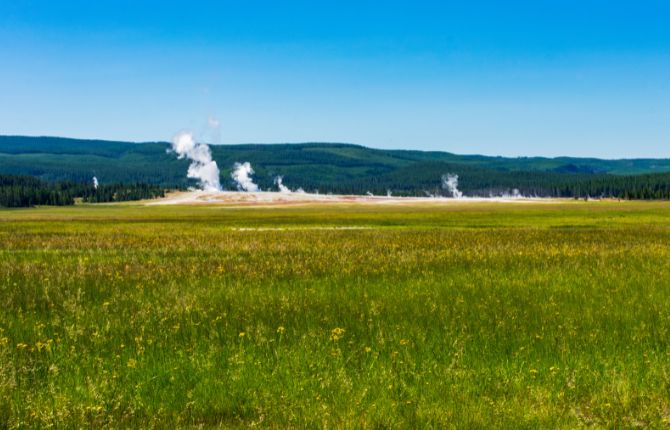
These changes can include unusual boiling, chemical changes to the water, and variations in spring activity. Recent changes have also included increased acidity, cloudiness, and an increase in activity for Echinus Geyser.
Echinus Geyser is the largest acid-water geyser in the world. Its water is nearly acidic, and it is as acidic as lemon juice. This acidity affects the formation of the sinter deposits around the geyser, as it can carry more dissolved silica.
Therefore, the sinter around the Echinus Geyser forms faster than those formed with alkaline water.
Aside from that, Porcelain Basin, Steamboat Geyser (the tallest active geyser in the world), and Back Basin are other attractions in this area.
The Norris Geyser Basin is an important part of Yellowstone National Park and worth visiting. It is located on the park’s western edge and features a National Historic Landmark.
A National Park road used to run through the area but has now been closed because of the fragility of the thermal features. It was once a popular stopping point for visitors.
Whether hiking through the Norris basin or looking for a scenic view, you’ll never get tired of this place.
While in the area, do not miss Norris Museum to learn more about hydrothermal features.
Depending on the season, you should dress in layers. The wind can be brisk in colder months over the geyser field. Bring plenty of water and a snack. While hiking through the park, you should wear good hiking shoes for the wood and gravel trails.
Address: Norris Geyser Basin, Wyoming 82190, United States
8. Mammoth Hot Springs
A thermal area is unique in its kind, and the Mammoth Hot Springs in Yellowstone is no exception.
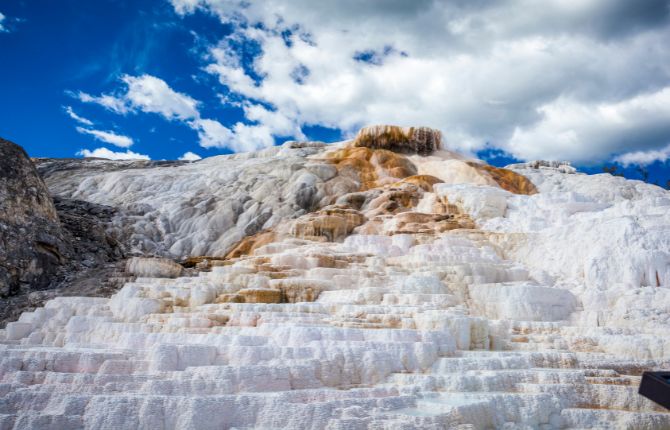
The limestone found in the area allows the formation of travertine, which looks like a cave turned inside out. Rain and melted snow seep into the earth and warm the water in underground chambers.
The partially molten magma chamber is evidence of a 600,000-year-old volcanic eruption.
The water is rich in calcium carbonate and flows into the Mammoth Terraces, which look like stair steps. They are filled with vibrant colors and intricate ripples of rock.
The travertine-covered terraces rise from the ground and form a series of travertine-like formations. They are the largest carbonate-deposit spring in the world. A visit to this beautiful spring will leave you refreshed and energized.
The town of Mammoth is the headquarters of Yellowstone National Park and offers year-round access. The area is known for mild winters and is also home to one of the most popular hot springs in the area.
Mammoth Hot Springs was once used by Native Americans as a healing source and were commercialized in the 19th century. President Teddy Roosevelt even visited Mammoth in 903 during his presidency.
The scenery at Mammoth Hot Springs is surreal. The surrounding mountains resemble ski slopes, and the presence of thermophiles enhances the hot springs’ orange hue.
It’s no surprise that postcards of the springs were hot commodities during the early 1900s. A postcard of Mammoth Hot Springs is a valuable souvenir for anyone traveling to Yellowstone.
Address: Yellowstone National Park, WY 82190, United States Phone: +1 307-344-7381
9. Minerva Terrace in Yellowstone National Park
A trip to Yellowstone National Park wouldn’t be complete without a visit to the Minerva Terrace.
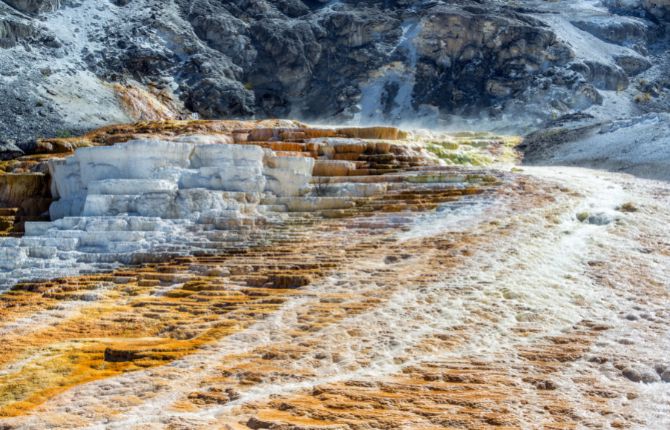
Located in Mammoth Hot Springs, this travertine formation was formed by underground geothermal activity. Visitors can reach the terrace from the Lower Terraces Boardwalk and the Upper Terraces Loop.
The former allows visitors to see the entire Mammoth Hot Springs area and is open year-round. The latter provides easy access to the terrace, even in winter, depending on the snowfall.
Visitors are invited to walk on boardwalks that go through the geothermal features. Minerva Terrace is one of the most famous geothermal features.
Liberty Cap is a 45-foot-tall travertine deposit named by the Hayden Expedition in 1871 because it is thought to resemble a patriot’s hat during the Revolutionary War.
Those who visit Minerva Terrace are encouraged to walk the trail and explore the surrounding geological features.
Visitors to the Terrace will be captivated by its beauty and its fascinating geological history. Throughout millions of years, the Yellowstone area was volcanically active.
This movement thinned the Earth’s crust and carved a hot spot. In this location, a subsurface magma dome built up and erupted 600 cubic miles of rock, ash, and material. This ejection of rock and ash caused great damage to the hydrothermal features and the Old Faithful geyser.
While in the area, visitors can also enjoy the Mammoth Hot Springs, a huge area of travertine terraces and springs. There are several notable features to see while hiking around the terraces, including the Canary Spring, Minerva Terrace, and Palette Spring.
Access to the terraces begins at the Lower Terraces parking area by the Liberty Cap, a dormant hot spring cone in the park.
Address: Mammoth, WY 82190, United States
10. Lamar Valley
If you want to explore the breathtaking landscapes of Yellowstone National Park, you should visit Lamar Valley.
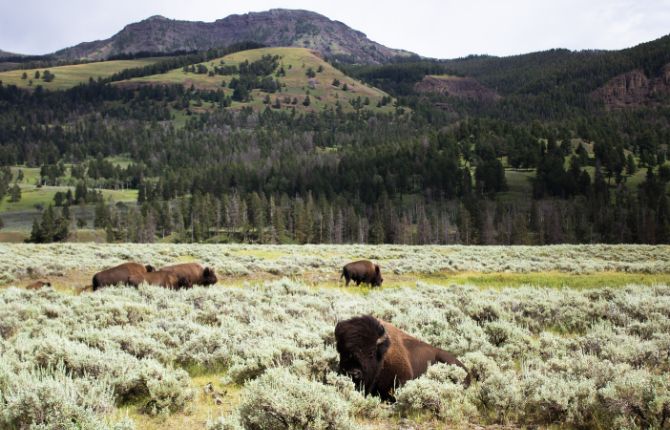
This valley is a popular destination for both outdoor enthusiasts and history buffs. It is accessible all year round on the road between Cooke City and Gardiner.
There are several points of interest in the Lamar Valley, including two primitive campgrounds. Pebble Creek and Slough Creek are two places to camp, and there’s also a buffalo ranch that hosts Yellowstone Forever field programs.
Bison are plentiful in Lamar Valley. While bison are commonly spotted along the road, you may encounter them on your travels.
During the summer, you can witness epic bison jams, bald eagles, badgers, grizzly bears, wolves, and coyotes.
Because of the increased numbers in the north in recent decades, the northern bison herd is now larger than the central herd. However, if you visit Lamar Valley in the winter, you will likely witness wolf sightings.
Soda Butte, a remnant of a hot spring cone, is another place to stop for a hike. You can also see Trout Lake, which is a short hike from the road.
11. Mount Washburn
When visiting Yellowstone National Park, don’t miss the opportunity to hike Mount Washburn, a spectacular peak.
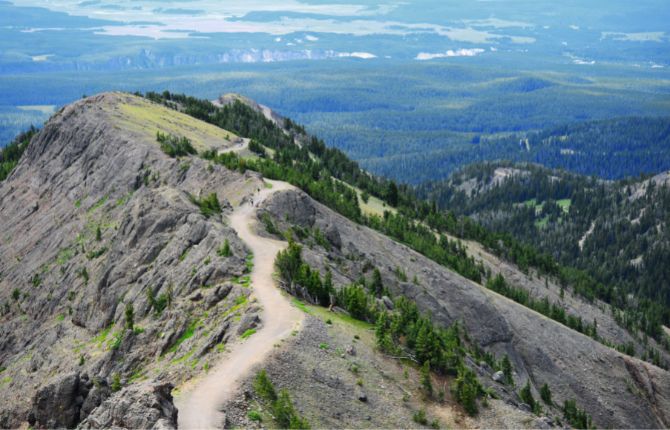
This volcano is one of the park’s three primary fire lookout towers (10,243 feet high). A viewing deck at the tower’s base offers views of the surrounding landscape, and the fire lookout tower’s enclosed structure protects it from strong winds.
Mount Washburn gets its name from Henry Washburn, who led the 1870 Washburn expedition. It’s possible to see bighorn sheep wandering around Mount Washburn near Dunraven Pass.
Mount Washburn Trail is best accessed from Dunraven Pass, four and a half miles north of Canyon Junction.
Hikers should wear sturdy shoes and bring plenty of water. The road to Dunraven Pass is one of the last to open in spring and closes early in the fall.
Check the weather forecast before setting off on your hike, as Yellowstone weather can change quickly. A thunderstorm is a no-no to climbing to the summit of Mount Washburn.
If you hike it during summer, you can see beautiful wildflowers, bighorn sheep, and breathtaking views along the way.
Hikers who prefer a less-crowded route can opt to ride their bikes up the mountain instead. While cyclists are not allowed to take the Dunraven Trail, the Chittenden road offers a smooth and scenic ride.
You’ll ascend 1,500 feet over 2.5 miles, but you won’t have to worry about avoiding the steep switchbacks. In either case, you’ll be rewarded with panoramic views of the park.
12. Yellowstone Lake
The ground beneath Yellowstone Lake is rising significantly, which indicates greater geological activity. So, it is considered the largest high-altitude lake in North America (7,737 ft).
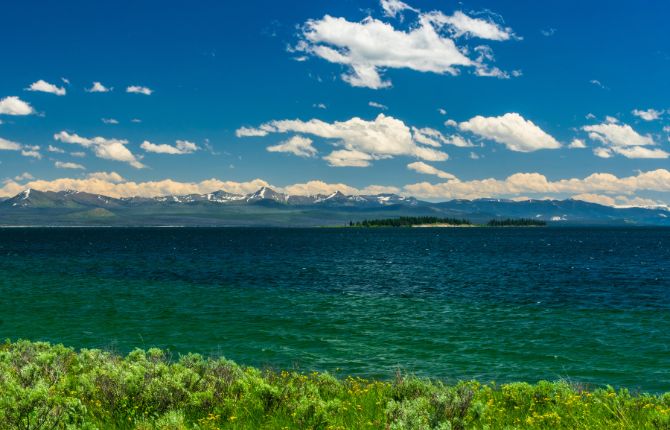
In 2004 a section of Yellowstone National Park was closed off to the public. In 2005, only limited parts of the park were off-limits. Geologists have discovered a “bulge” under Yellowstone Lake with numerous faults, hot springs, and small craters.
The origin of the “bulge” is unknown, but the lake’s rift valley is similar to the region’s volcanic history.
The area around the lake is home to several species of birds, including bald eagles, northern harriers, waterfowl, sandhill cranes, and shorebirds.
Below the bridges are mud pots and the Sulphur Caldron, one of the park’s most acidic springs. The area also features a wheelchair-friendly loop, which passes Dragon’s Mouth Spring and Black Dragon’s Cauldron.
Fishing is another popular activity in the area. You can rent a boat for the day from the Bay Bridge Marina. If you want to go further, you can rent canoes or kayaks for a day’s worth of fishing.
There are many fish species in the lake, and you can even take a guided tour on a canoe. However, you’ll need to obtain a fishing permit from the National Park Service and be sure to get checked for aquatic invasive species before you fish.
Fishing enthusiasts will be delighted to know that Yellowstone Lake is home to one of North America’s largest lakes. It is also home to the continent’s largest population of wild cutthroat trout.
The lake’s northern shore is home to several motels, campgrounds, and small towns, including Fishing Bridge, Bridge Bay, and Lake Village.
This lake is not recommended for swimming since the water is often frozen during winter. For this reason, the area is also a great place to catch fish and admire its beautiful scenery.
So, next time you’re in the park, make sure you make time for fishing at Yellowstone Lake. It’s sure to be a memorable experience. So, what are you waiting for? Go out there and discover the wonders of Yellowstone Lake in Yellowstone National Park!
13. Upper and Lower Falls of the Yellowstone River
If you’ve ever wanted to see the Upper and Lower Falls of the Yellowstone River, there are a few things you need to know before making the trip.
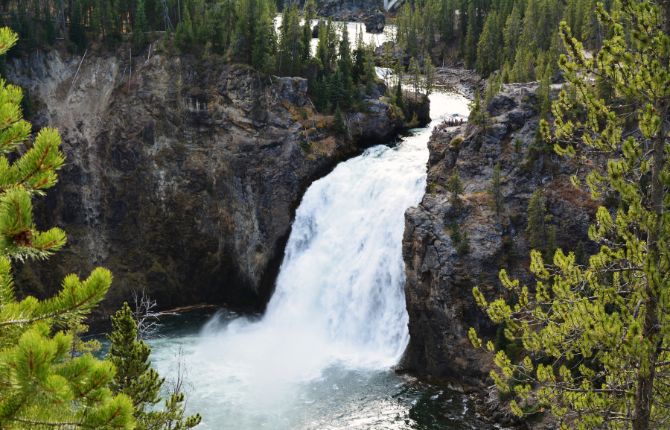
These waterfalls are located in Yellowstone National Park in Park County, Wyoming, and emerge from Yellowstone Lake through the beautiful Hayden Valley.
You can contact the National Park Service if you’d like to learn more about the park and the falls.
The hike to Upper and Lower Falls is 0.7 miles round trip and relatively difficult, requiring a steep descent of about 600 feet. The trail includes switchbacks down the canyon walls and resting areas. This hike is not for everyone, but it’s well worth the magnificent views.
The Upper Falls can be viewed from Uncle Tom’s Trail and the Brink of the Upper Falls Trail.
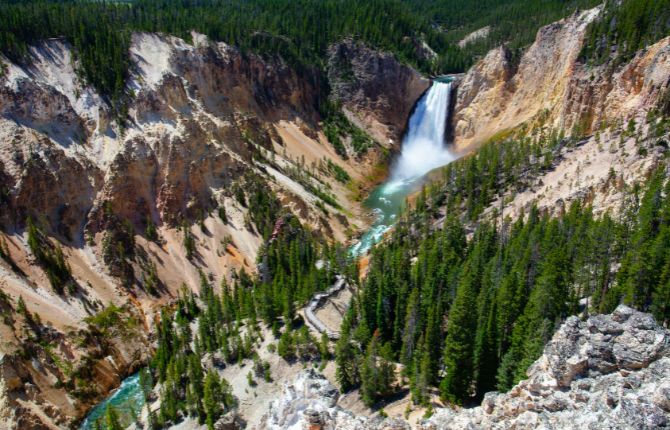
And if you have young children, the Lower Falls is a great option. It is twice as high as Niagara Falls. Lower Falls is awe-inspiring during the summer when a rainbow lingers in the splash below.
You can get breathtaking views of Lower Falls from Artist Point, Lookout Point, Red Rock Point, Brink of the Lower Falls Trail, and South Rim Trail.
Especially the park’s South Rim Trail is one of the most popular hiking routes.
The Falls are one of the lesser-known wonders of Yellowstone. No other natural attraction can compare to the Upper and Lower Falls. And you can visit them within two hours of your ranch.
And if you’re interested in exploring the park, make sure to plan an early arrival – before the crowds arrive. There’s no better way to see the Upper and Lower Falls than early morning!
14. Hayden Valley
You are in for a treat for those of you who have not yet visited Hayden Valley. This picturesque area is one of the many reasons to visit Yellowstone National Park.
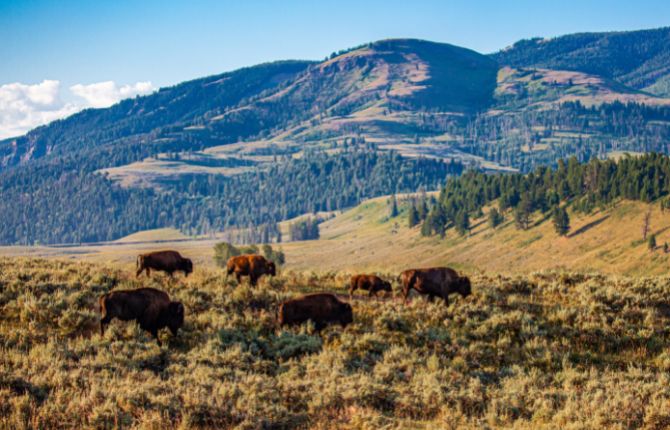
This area is perfect for hiking, horseback riding, or spotting wildlife for a scenic adventure. You’ll find all kinds of wildlife here, including bison, bears, coyotes, and wolves. And if you’re planning a family trip, you’ll have plenty of time to explore this spectacular region.
In Hayden Valley, you can also view a subalpine meadow, which lies straddling the Yellowstone River. The region is rich in wildlife and is home to many spectacular thermal formations, including the Mud Volcano and Sulphur Cauldron.
However, it’s important to remember that because it is in the center of Yellowstone National Park, traffic in the area can become a problem, especially during the summer when bison are often present on the road.
The shortest route from West Yellowstone to Hayden Valley includes Madison, Norris, and Canyon Village stops. You’ll arrive at the valley in one hour and fifteen minutes, but delays can add significant time to your journey.
You can also take the Grand Loop Road south. Google maps indicate that this route will add an additional 45 minutes to your travel time. You’ll also add another 25 miles to your odometer.
Aside from the scenery in Hayden Valley, you can also see wildlife like bison, elk, and grizzly bears. If you’re lucky enough to spot these animals, you can use binoculars or a spotting scope. However, remember to keep a distance from them!
The National Park Service advises that visitors stay at least 100 yards away from wolves and bears. This is because these animals are nocturnal and can hide in the grass.
On the other hand, Hayden Valley’s mud flats and river attract diverse birds, including northern harriers, bald eagles, shorebirds, ducks, sandhill cranes, geese, and pelicans.
15. Mud Volcano
You’ve probably already heard of the Mud Volcano in Yellowstone National park. Located north of the park’s main attraction, the lake, it’s easy to visit and offers unique geothermal features. (a few miles below Fishing Bridge)
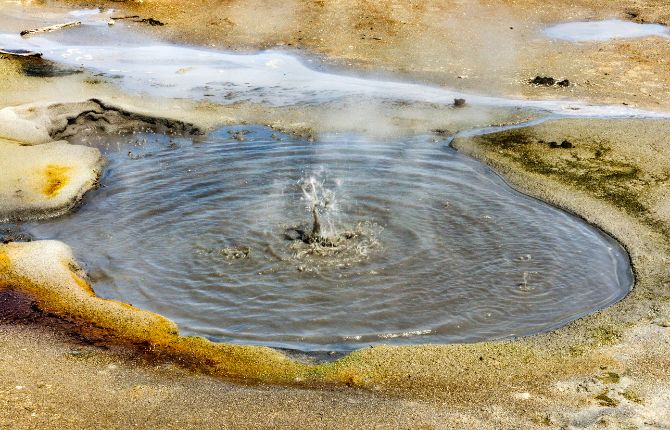
Its unique smell is the result of evaporating gases. There are two trails to the Mud Volcano, one a quarter mile long and the other 0.7 miles.
Due to its sulfur content, this area is also known as the Mud Volcano Area. Mud Volcano Area and Sulphur Caldron are some of Yellowstone’s most acidic springs.
The sulfur here is converted into hydrogen sulfide, which gives off the area’s distinctive aroma. In addition to the sulfur, the region’s features are painted yellow and gray by sulfur minerals.
Visitors to the Mud Volcano are likely to encounter wildlife here. Grizzly bears feed off of winter-killed animals in the spring.
The Mud Volcano Trail is a 20-minute drive from Canyon Village. Traffic tends to back up around the park’s main attraction, Yellowstone Falls. However, you should still allow time to reach this attraction.
The road is famous, so expect to wait for parking. The park’s Mud Volcano is popular, so expect to see many people. To avoid this, consider renting a car in advance.
16. Grizzly & Wolf Discovery Center
If you love animals, you might be interested in visiting the Grizzly & Wolf Discovery Center, located in the national park’s southwest corner.
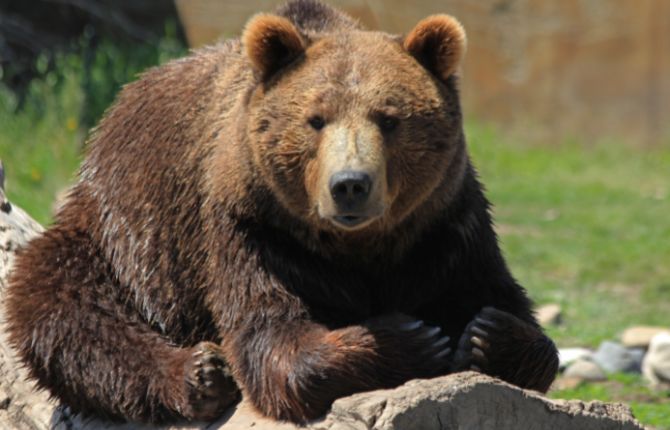
The Grizzly and Wolf Discovery Center features grizzly bears, Yellowstone wolves, river otters, and birds of prey such as eagles, falcons, and hawks.
Visitors can view these animals from close quarters and learn about their co-existence.
The animal center is home to two groups of bears and wolves, which were originally displaced from Yellowstone National Park after becoming too friendly with people.
Although wolves and bears are considered a threat to human life, many other animals in the wildlife park are safe to view. Other animals in the park include Karelian bear dogs, birds of prey, and other mammals.
Despite its small size, the Grizzly and Wolf Discovery Center features educational displays about bears and their habitats. Learn more about bear behavior and safety by checking out the bear-resistant packaging in the Grizzly and Wolf Discovery Center.
Bears are known to be some of the fastest animals on the planet. Grizzly bears can reach 35 mph!
There’s also a Keeper Kids program at the Grizzly and Wolf Discovery Center that lets kids experience the life of a grizzly bear for a few minutes. This program will give kids a chance to hide food for the bears to find.
Address: 201 S Canyon St, West Yellowstone, MT 59758, United States Phone: +1 800-257-2570
Yellowstone National Park
- Old Faithful
- Upper Geyser Basin
- Morning Glory Pool
- Midway Geyser Basin
- Lower Geyser Basin
- Grand Prismatic Spring
- Norris Geyser Basin
- Mammoth Hot Springs
- Minerva Terrace
- Lamar Valley
- Mount Washburn
- Yellowstone Lake
- Upper and Lower Falls of the Yellowstone River
- Hayden Valley
- Mud Volcano
- Grizzly and Wolf Discovery Center
Yellowstone National Park


